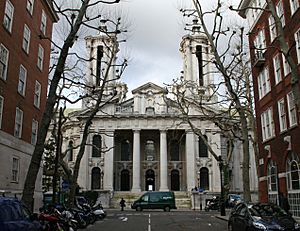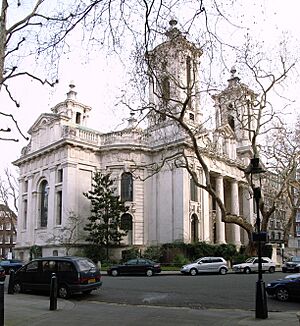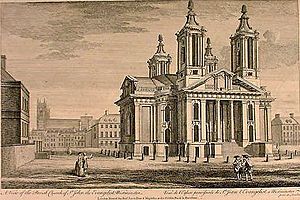Smith Square Hall facts for kids
Quick facts for kids Smith Square Hall |
|
|---|---|

Smith Square Hall as seen from Dean Bradley Street
|
|
| Location | Smith Square, Westminster, London |
| Country | United Kingdom |
| Website | https://www.sinfoniasmithsq.org.uk/ |
| History | |
| Dedication | St John the Evangelist |
| Events | Firebombed 10 May 1941 |
| Architecture | |
| Functional status | Concert hall |
| Architect(s) | Thomas Archer |
| Style | English Baroque |
| Completed | 1728 |
Smith Square Hall (once known as St John's Smith Square) is a famous concert hall in the heart of Smith Square, Westminster, London.
This amazing building was first a church. It was designed by Thomas Archer and finished in 1728. It was one of the "Fifty New Churches" built at that time. People think it's one of the best examples of English Baroque architecture. It has four cool corner towers and big, fancy pediments.
Many people call it 'Queen Anne's Footstool'. The story says that when Archer was designing the church, he asked Queen Anne what she wanted it to look like. She supposedly kicked over her footstool and said, "Like that!" This gave the idea for the four corner towers.
During World War II, the church was badly damaged by bombs. It was then sold to a charity and fixed up to become the concert hall we know today. In 2024, it was officially renamed Smith Square Hall.
Contents
History of Smith Square Hall
Building the Church
In 1710, a new government came to power in Britain. They wanted to make the Anglican Church stronger. After a big storm damaged many churches, Parliament decided to build 50 new churches in London and Westminster.
In 1711, a special tax on coal imports was put in place to pay for these churches. A group was set up to manage the project. Thomas Archer, the architect, was part of this group.
The land for St. John's was bought in 1713. Building started right away, but it was slow work. The church was finally finished and opened in 1728. It cost a lot of money, about £40,875.
The 'Queen Anne's Footstool' Story
The church got its famous nickname, 'Queen Anne's Footstool', early on. The legend says that Thomas Archer asked Queen Anne for her ideas on the church design. The Queen, who wasn't very interested in architecture, supposedly kicked over her footstool. She pointed at its shape and said, "Like that!"
However, the towers were actually added for a practical reason. They helped to make the building stable because the ground was a bit marshy.
Important Events and Damage
For 213 years, St. John the Evangelist served its local community. But the building seemed to have a lot of bad luck! In 1742, a fire damaged the inside, and it needed a lot of repairs. In 1773, lightning struck it. In 1815, the towers and roof needed fixing.
Then, on May 10, 1941, during a bombing raid in World War II, the church was hit by a bomb. It caught fire and was completely burned inside. For over 20 years, the church stood as a ruin, open to the sky.
Becoming a Concert Hall
Work to restore the building began in 1965. It reopened as a concert hall in 1969. The first concert was given by famous singer Dame Joan Sutherland.
In 2021, the charity that runs St John’s Smith Square joined with an orchestra called Southbank Sinfonia. In 2024, the building was officially renamed Smith Square Hall.
Architecture of Smith Square Hall
The look of St John's, Smith Square, has always made people have strong opinions. Some people in the 1700s thought it looked "odd." Later, the writer Charles Dickens said it looked like "some petrified monster." But today, most people see St John's as a masterpiece of English Baroque architecture.
Thomas Archer's Design
The building was designed by Thomas Archer (1668–1743). We don't know how he learned to be an architect. He traveled around Europe for three years, which was common for wealthy young men. He became a court official for Queen Anne. He was in charge of licensing gambling at court.
Archer became very rich. He didn't design many buildings. But his unique style, which you can see in St John's, is in all his work. He was inspired by Italian architects like Borromini.
What the Building Looks Like
The building is almost square. Inside, the spaces flow together in a way that makes you feel like you can see the church from different angles. The outside is full of movement. It's made of classical parts like columns and fancy tops.
One expert, Sir Hugh Casson, described it in 1981. He said Archer handled all these parts with great energy and confidence. The building looks a bit big for the small square it's in. It's like a huge machine parked among smaller houses. But this grand, oversized look is part of its charm.
When you go inside, it's a complete change. It's quiet and simple. It's a tall, open space filled with pale, clear light. There's no stained glass. The white walls contrast with a red curtain and a dark, shiny wooden balcony. Big white columns hold up a simple curved roof. It feels cool and quiet, like the inside of a seashell.
Restoration as a Concert Hall
Saving the Building
Lady Parker of Waddington was determined to save the building. She is remembered with a plaque on the hall's south wall. In 1962, she started the "Friends of St John's" group. Their goal was to raise money and bring the church back to its original beauty. They wanted it to be used as a concert hall.
Work began in 1965. The hall officially reopened for concerts on October 6, 1969. The famous singer Dame Joan Sutherland gave the first performance.
A Great Place for Music
Since it became a concert venue, St John's, Smith Square, has become one of London's most important concert halls. Its sound quality is excellent for almost all types of music. The space is flexible, so it can host many different kinds of musical events.
The concert season usually runs from mid-September to July or August. It hosts concerts by famous singers and musicians. You can also hear professional orchestras and choirs, as well as amateur groups and school performances.
Funding and the Organ
St John's does not get money from the government. It relies on money from concerts and recordings. It also depends on generous donations from charities, companies, and individuals. This money helps it survive and improve its facilities.
In 1986, a project started to raise money for a new concert organ. An old organ case from 1734 was donated. After many donations and two big concerts, the new organ was finished in 1993. It was built by Johannes Klais of Bonn. The organ was named "The Sainsbury Organ" because the Sainsbury family gave a very large amount of money to the project.
In 1999, the outside of St John's was cleaned and repaired. The National Heritage Lottery Fund helped a lot with the costs. The 30th anniversary of St. John's as a concert hall was celebrated on October 6, 1999, with a special concert.
The hall even appeared briefly in the 2009 film An Education. However, this was a mistake, as the film was set in the early 1960s, before the hall was restored.
Access for Everyone
Until 2010, it was hard for people with disabilities or the elderly to get into St John's. The main entrance had 14 steep steps. Inside, there were also steps to the restaurant and the main hall.
A plan was put in place to fix this. A lift was installed to reach all levels: the ground floor, the crypt (where the box office and restaurant are), and the concert hall. The box office and main entrance were moved closer to the lift. This made it easier for everyone to enter. Special restrooms were also added in the crypt. Performers with disabilities can now also get onto the stage using a platform lift.
The Crypt
You can get to the crypt by stairs from the main entrance or by a spiral staircase inside. This part of the building was not damaged during the wartime bombing. So, the brickwork you see there is the original from the 1700s.
Unlike some other old churches, the crypt at St. John's was never used for burials. For most of the 1700s and 1800s, the space was rented out for storing wine and beer.
Burial Ground
The church's old burial ground is on Horseferry Road. It's now called St. John's Gardens. The old grave-slabs, which are very worn down, are placed around the edges of the garden.
See also
 In Spanish: Iglesia Plaza de San Juan en Londres para niños
In Spanish: Iglesia Plaza de San Juan en Londres para niños




